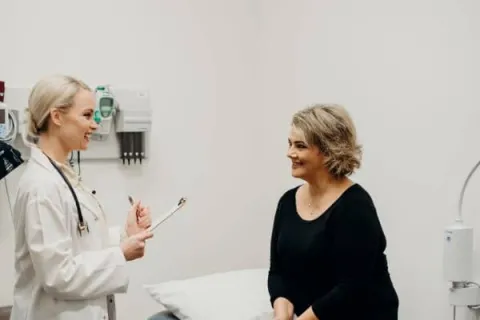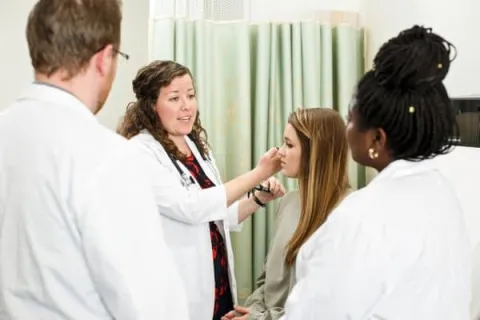5 Examples of Evidence-Informed Nursing Practice Protocols

Evidence-informed practice in nursing is an approach to patient care that incorporates the best research, clinical expertise, and patient input. The premise of this problem-solving approach is simple: to provide the best in patient care.
Florence Nightingale first introduced the idea of evidence-informed practice in nursing nearly 200 years ago. She used the strategy during her time as a wartime nurse for the British Army when she observed how poor ventilation and the unsanitary conditions of the soldiers negatively impacted their health. Her findings led to vast changes in the way hygiene in hospitals was viewed, including layouts of hospitals to decrease the spread of infection. This laid the groundwork for what would become evidence-informed practice.
Today, evidence-informed practice in nursing is a foundational part of Family Nurse Practitioner programs. It has become an increasingly important element within the health care industry as a whole, and for good reason. Significantly, evidence-informed practice in nursing helps keep clinicians current on research and it empowers them with numerous strengths that allows them to have a positive effect on health care processes.
Evidence-informed practice stresses the use of individualized patient care, encouraging more conversation between provider and patient. That interaction leads to the creation of a better overall treatment plan, increasing the chance of a better patient outcome.
When better patient outcomes are achieved, the benefits actually don’t stop there. Evidence-informed practice leads to greater transparency and accountability as the patient is brought into the conversation and decision-making process. The approach leads to cost savings as the demands on health care resources and providers are decreased.
A Healthcare Financial Management Association article explains it best: “In addition to curbing cost, evidence-based care addresses six components of healthcare quality: safety, effectiveness, patient-centeredness, timeliness, efficiency, and equitability.”
Request My Free Marymount Accelerated BSN Program Guide
Protocols of Evidence-informed Practice in Nursing
The idea of evidence-informed practice in nursing has developed greatly over the years. For decades after Nightingale, there was no movement on the practice. Up until the 1960s, nursing was still generally viewed as more of an applied science that was based on theory rather than research. Then came professor Archie Cochrane. Often called the father of evidence-informed medicine, Cochrane noted that problem in the 1970s, stressing the need for evidence in medicine. By the mid-1990s, it was realized that new knowledge alone wasn’t enough. It must be applied in clinical settings, preferably across an entire team.
Evidence-informed medicine became more of a focus in the 1980s and 1990s, and it replaced many protocols and policies that were at one time standard.
For example, previously, a BRAT (bananas, rice, applesauce, and toast) diet was standard for children with gastrointestinal issues. Today, it’s known that children with gastrointestinal issues should continue a well-balanced diet as quickly as possible.
Previously, protocol said to turn a patient every two hours to avoid skin breakdowns. Evidence-informed practice revealed that patients should be turned when and if their condition permits. Another protocol change is that at one time aspirin was given to children to control fever. With evidence-informed practice, however, this has changed because it has been proven aspirin increases the risk of Reye’s syndrome.
Thankfully, evidence-informed practice has become a greater part of the daily routines of nursing throughout the industry. There are numerous examples of great strides in patient care thanks to these practices. Let’s take a look at five protocols of evidence-informed practice in nursing to better understand the benefits to health care.

5 Examples of Evidence-informed Practice in Nursing
Ventilator-associated Pneumonia
A common health care-associated infection is ventilator-associated pneumonia, a nosocomial infection that can occur during prolonged periods of mechanical ventilation. Reports estimate that ventilator-associated pneumonia affects 10% to 20% of patients on ventilators each year in the United States. To combat what is a preventable problem, evidence-informed guidelines have changed how nursing practices are handled.
The Institute for Healthcare Improvement developed the “ventilator bundle” protocol in 2001 to significantly reduce the risk of ventilator-associated pneumonia. This includes:
- Elevating the head of the bed between 30 to 45 degrees. This prevents aspiration of gastric content and helps with secretion drainage.
- Performing a daily sedation interruption. Continuous sedation can lead to over-sedation, which is associated with an increased risk of ventilator-associated pneumonia.
- Avoiding scheduled ventilator circuit changes. Frequent changes of the circuit increase the risk of ventilator-associated pneumonia.
Many ICUs have implemented the ventilator bundle since the guidelines were published. According to the Institute for Healthcare Improvement, hospitals have seen significant improvement with ventilator-associated pneumonia rates following the bundle guidelines, with “some even reaching zero by taking a comprehensive and multidisciplinary approach to ventilator care.”
Oxygen Therapy and COPD Patients
It was once believed that providing oxygen to COPD patients could lead to serious health issues such as hypercarbia and acidosis. Some even believed it could lead to death. Yet today, a significant evidence-informed protocol is to provide oxygen to patients with COPD to prevent hypoxia and organ failure.
Why is oxygen therapy now the standard of care? Because it’s now known—thanks to solid research—that oxygen therapy can actually improve quality of life for COPD patients. It has been shown to help COPD patients feel better and be more active. Another landmark study found that long-term oxygen therapy could potentially prolong the life of COPD patients.
Adolescent Patients in Inpatient Care
Because of evidence-informed research, nurses today know that children in inpatient care benefit from daily bathing with 2% chlorhexidine gluconate. A study by Cincinnati Children’s Hospital showed that daily bathing with this solution reduced the risk of an infection in the bloodstream. In fact, the study goes on to show that 2% chlorhexidine gluconate bathing every other day instead of daily soap and water bathing reduced the risk of infection by as much as 45%.
Preventing Intestinal Blockage After Abdominal Surgery
Abdominal surgery patients often experience intestinal blockage post-surgery, known as postoperative ileus (POI), which causes intense pain and suffering. A study piloted by a group of oncology nurses found that there is a simple way to prevent POI: chewing gum. Research conducted found that gum-chewing patients improved more quickly, had better overall outcomes, and even had shorter hospital stays.
These particular nurses found that of 159 patients who underwent abdominal surgery during a specific timeframe,15 patients developed POI. Five of those patients had chewed gum, while 10 did not. A report published by the International Journal of Clinical and Experimental Medicine reported another study that showed only 27% of gum-chewing patients developed POI as compared to 48% of patients in the control group who did not. This led to the suggestion that “chewing gum has emerged as a novel and simple strategy for promoting the recovery of gastrointestinal function.”
Stress Reduction in Nurses
Evidence-informed protocols extend well beyond just the care of patients. They apply to the care of nurses.
It’s well known that nursing is an occupation that comes with high levels of stress and anxiety. In some cases the stress of the job even leads to depression or burnout, especially for those working in areas like emergency rooms and oncology units.
One proven practice is Mindfulness-Based Stress Reduction (MBSR), which seeks to reduce “psychological distress among nurses.” According to a National Library of Medicine article, studies found MBSR reduces stress, anxiety, and depression among nurses. Furthermore, studies revealed the protocol leads to increased job satisfaction and less burnout. In one particular study, all 36 nurse participants showed improved general health, decreased stress, and decreased work burnout, and these changes were sustained at least four months later.

Evidence-informed Practice in Nursing and Population Health
It’s clear that evidence-informed practice in nursing has a significant impact on finding and implementing methods to improve patient care. The three-pronged approach—combining solid research with clinical expertise and patient input—can further impact overall population health.
As a noted evidence-informed handbook for nurses states, the combination of research with clinical expertise leads to better decision making by clinicians. But using solid research also leads to better decision making in creating public policies and practices, as noted by the Office of Disease Prevention and Health Promotion (ODPHP).
ODPHP, under the U.S. Department of Health and Human Services, states that “there is demand for evidence at many levels.” This ranges from practitioners to senior managers within the government and health care organizations that “use it to set priorities and make policy and funding decisions.”
As explained in ODPHP’s “Healthy People Initiative” for 2020, integrating proven research with clinical expertise helps avoid pitfalls of creating treatments and plans without clear evidence. For example, a breast cancer treatment was implemented in the 1980s without proper testing. Eventually, research proved it ineffective and that it actually contributed to the premature death of thousands of women.
Evidence-informed practice has positively contributed to population health as it has found many routine screening tests unnecessary. Evidence shows routine screening in some cases leads to false positives and unnecessary psychological harm. Two separate studies concluded the inaccuracy of routine testing: one regarding abdominal aortic aneurysms in women and another regarding men aged 65 to 75 who have never smoked.
A Team Approach to Evidence-informed Practice in Nursing
The value of evidence-informed practice to patient outcomes and overall population health is clear. That’s why today more than ever, this is essential for nursing teams in everyday tasks. According to the Institute for Healthcare Improvement, evidence-informed practice is what helps clinicians reach the Triple Aim:
- Improve patient experience: Improving patient health and meeting their expectations, which includes access to quality, coordinated care.
- Improve population health outcomes: Improving population health is the primary goal of the Triple Aim. This is believed to reduce per capita cost of care and allow businesses to be more competitive and less financially burdened.
- Decrease costs: The U.S. health care system is the most expensive in the world. One evidence-informed practice expert notes that “the U.S. healthcare system could reduce its healthcare spending by a whopping 30% if all patients received evidence-based healthcare.”
Yet for evidence-informed practice in nursing to truly be successful, the entire team must buy-in. This starts from the top, so nurse managers play a pivotal role in implementing the method. Feeling supported by superiors encourages novice nurses—and those at any level—to implement evidence-informed protocols whenever possible.
Steve Risch, MSN, RN, CCRN, CCNS suggests that interprofessional teams come together to establish implementation strategies as “advanced practice nurses and professional development educators are key stakeholders and experts in implementing” evidence-informed practices. The National Library of Medicine notes that while chief executive nurses have not routinely placed a high priority on implementing evidence-informed practices, they and the hospital administrators must work toward creating the culture so that clinicians will view evidence-informed practice as the standard of care.
The Institute of Medicine has issued recommendations for health care professionals to lead the way in implementing evidence-informed practice in nursing, and the American Nurses Association has updated its standards to put the practice into place. That has paved the way for nurse managers to create the workplace culture and empower “nurses under their supervision to use EBP and drive change.”

Evidence-informed Practice Knowledge Is Power
Evidence-informed practice has become foundational to the nursing profession. It’s needed for nurses in all settings and in all skill sets. That’s why it’s critical to learn about the approach and how to apply it to patients whenever possible.
The Benefits of Evidence-informed Practice in Nursing in Clinicals
Clinicals are a great opportunity to delve into evidence-informed practice in nursing, and it’s an important part of a Doctor of Nursing Practice - Family Nurse Practitioner program. Students benefit from assignments with specific populations by performing research and finding pertinent evidence-informed practices. Furthermore, clinicals are a time nursing students can proactively explore proven practices that should be considered or implemented under the leadership of experienced professionals in the field.
The sooner evidence-informed practice in nursing is learned, the sooner it will elevate your knowledge. It will expand the role of research in decision-making and help you more quickly make the right call for patients.
In the end, evidence-informed practice in nursing enables you to become a better advocate for your patients. And developing the mindset will offer competitive advantages when it comes to furthering your career:
- Possessing the knowledge of evidence-informed practice in nursing means you’re equipped with a critical skill set and nursing prioritization.
- Because you are more competent and trustworthy in making decisions, you are more valuable to patients and employers.
- Utilizing evidence-informed practice leads to more critical thinking and a better ability to adapt to any given situation.

A Benefit to Avoiding Job Burnout
The implementation of evidence-informed practice in nursing can help prevent burnout and guide clinicians to more easily achieve what has become the “quadruple aim”: improving the work life of clinicians. An American Journal of Accountable Care study found that over half of all clinicians in the United States experience symptoms of burnout. They report that approximately 60% of newly licensed registered nurses actually quit their first professional job in the first two years due to burnout.
Many believe that the implementation of evidence-informed practice in nursing actually contributes to a nurse’s long-term career satisfaction. That’s due to many factors, such as improving patient care and continuously expanding their knowledge and skills. Adds Bernadette Mazurek Melnyk, PhD, RN, APRN-CNP, FAANP, FNAP, FAAN, a member of the American Association of Nurse Practitioners, “In a time when NPs and many other providers experience symptoms of burn out, [evidence-based practice] can be empowering.”

Are You Ready to Start Your Nursing Journey?
The entry-level option for students with non-nursing undergraduate degrees is the Online ABSN. In just 16 months, Online ABSN students complete the following requirements in preparation for RN careers:
- An on-campus residency
- Clinical placements in Virginia
- 100% online courses on topics like Research and Evidence-Based Practice
Marymount’s ABSN is accredited by the Commission on Collegiate Nursing Education (CCNE). Nursing courses at Marymount are taught by practicing APRNs who can speak with authority about the profession. The university’s stellar reputation is confirmed by top U.S. News & World Report rankings in its National Universities and Nursing categories.
If you want to become an RN, contact one of our student advisors to discuss if this program is right for you.
Request My Free Marymount Accelerated BSN Program Guide
